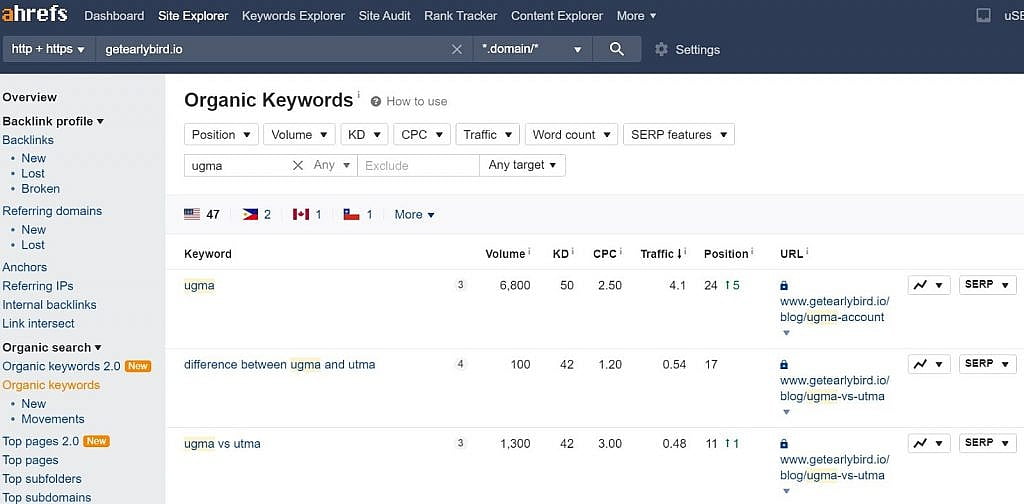Whether you’re using blogging for business growth or affiliate marketing, you need to have the right tools at your disposal.
Using the right blogging tool can make writing, editing, and outreach faster and more efficient. Online tools and platforms can also speed up your blog post creation process, giving you more time for research, analysis, outreach, ideation, and even taking on more work.
While manually checking every spelling, implementing on-page SEO, or handling outreach can take hours, the correct tools can help you complete tasks in minutes.
The 7 Top Blogging Tools of 2021
Table of Contents
1. Ahrefs: Best for SEO
SEO and blogging go hand-in-hand. There’s no point in spending hours writing an excellent blog post if no one reads it.
If you want your blog to get a good ranking on Search Engine Result Pages (SERPs), you need to target the right keywords.
Ahrefs, a leading provider of SEO tools, is well-known for its keyword research feature. Keyword research and optimization help with SERP rankings, but it’s also a great source for blog ideas.
To understand how Ahrefs works, let’s take this blog from Earlybird as an example.
The keyword is “UGMA.” Typing that in Ahrefs will give you the following results:


Ahrefs shows you the metrics for your keyword and also indicates related keywords that you can use. With these results, the content team at Earlybird can structure their article to have the maximum impact and improve their chances of reaching the target audience.
Users can also sort keywords by specific metrics, such as volume, traffic, and position, using this SEO tool.
Ahrefs’ other features include an SEO audit of your website, competitor analysis, and a rank tracker. It’s a dynamic tool that is perfect for content marketing and digital marketing.
2. Grammarly: Best for Error Checking
English language skills have become essential for businesses, with one study stating that mastering the language can increase your annual income by 30%.
When it comes to blogging, it’s worth noting that poor English — be it incorrect word usage, poor spelling, or improper punctuation — can turn readers away.
Poor English can also hinder your chances of being considered an industry expert.
Grammarly is an essential writing tool that solves the most common spelling and grammatical issues.
It’s available as a browser extension and highlights grammatical errors in any text, be it a Google Doc, an email, or a social media post. You can correct spellings and punctuations with a click and replace misused or overused words just as quickly.
The app’s functionality across different social media channels and web platforms make it a must-have for bloggers.
3. YoastSEO: Best for WordPress SEO
WordPress powers 40.5% of all websites. If you’re among the millions that use this content management system for your blog, then you’ve probably heard of Yoast SEO.
Yoast SEO is a leading WordPress plugin that offers keyword optimization, checks your blog’s readability, and identifies duplicate content.
The plugin’s premium version can help you elevate your WordPress blog by finding and adding high-performing keywords, indexing optimization, internal linking suggestions, and integration with other tools such as Zapier and Elementor.
These features aim to help bloggers, be they experts or rookies, get better SERP rankings and reach a bigger audience.
4. Google Analytics: Best for Analytics
One of the easiest ways for a blogger to check how their site is performing is using Google Analytics.
This free tool can help site owners and web workers track Key Performance Indicators (KPIs) on a blog page or overall website.
It provides real-time data on your website traffic, custom reporting options, advanced segmentation, conversion reporting, and more.
Understanding how visitors move through your site can help you tweak your website and increase blog traffic.
For example, you can identify your most popular blog post and promote it extensively, while simultaneously creating similar content.
5. Drift: Best for Live Chat
A successful blog provides readers with valuable information that keeps them coming back for more.
When your customers are already engaged in content and have questions, you don’t want them to leave your site to get answers.
You also don’t want readers interested in your brand or products to have to look around for contact information.
This is where live chat comes in.
A live chat on your blog can help readers get quick replies to their queries and build a connection with your brand.
Drift, a self-proclaimed revenue acceleration platform, helps you connect with customers by creating custom live chat sequences.
For example, Track-POD features an automated Drift chat on their blog. The chat pops up and prompts users to ask any questions about route optimization software or other topics on the site.


Drift allows users to set up custom automated options. So, if a reader wants to book a meeting, you can set up a sequence of automatic responses that ask for their basic details. It’s then a simple matter to show available times and dates.
In simple terms, you can set up a live chat sequence to automatically handle the most common customer queries and give your audience the chance to talk to a real customer support executive, if needed.
6. Voila Norbert: Best for Outreach
Outreach is essential for blog growth. Building connections with peers, guest posting, and cross-promoting can help bloggers build credibility, get more readers, and establish themselves as industry experts.
Voila Norbert can help you find anyone’s email address with a simple search. You just need to know their name and website.
The software is useful for more than finding emails. You can add emails to a list and then send a message to everyone on it. You can keep team members informed of progress with a particular lead by starting discussions.
Voila Norbert beats out its competitors because of the number of integrations it offers. Some tools it can integrate with include Gmail, Drip, ReplyApp, Hubspot, Close.com, and other CRM platforms.
7. Buffer: Best for Social Media
Social media has become an integral part of every blogger’s life. Social sharing is the best way to get your content out there, interact with readers, and collaborate with others in your industry.
Buffer is a social media management platform that helps you plan, publish, and analyze your posts and engagement across Instagram, Twitter, Facebook, and LinkedIn.
This great tool helps you share your blog content via customized posts for each social media platform. Posts can be planned months or weeks in advance. You can also get reminders for when it’s time to publish.
Once you’ve started sharing your blog posts on social media, you can get in-depth analytics for how they’re performing on Twitter, Facebook, LinkedIn, and Instagram.
You can also see and instantly reply to comments across platforms on your dashboard to build engagement with your audience.
Buffer is a market leader when it comes to social media management, and it’s easy to see why.
Conclusion
The tools listed in this article are just 7 of the hundreds available on the market today. You don’t need to break your bank and get the most expensive tools to make the most impact. Apart from the tools listed above, bloggers can use tons of inexpensive Add-Ons for Google Docs to gain a ton of additional functionality and make blog post creation effortless. Graphic design tools like Adobe Photoshop can also help you create visually appealing blog banners and other creatives for your blogs.
Your main goal should be to pick the right tools for you and your team and use them together to build an engaged reader base.
Photo by Sincerely Media on Unsplash






